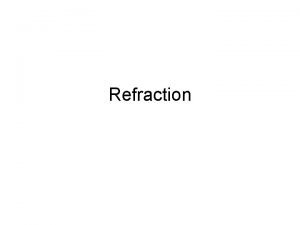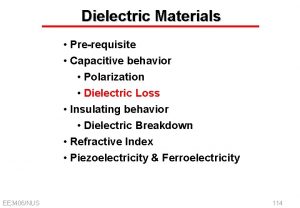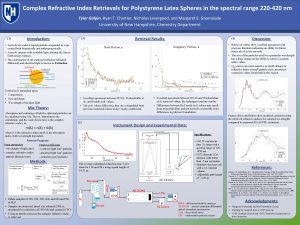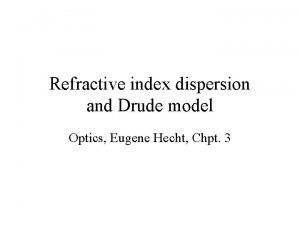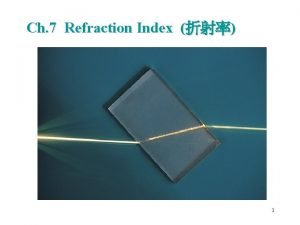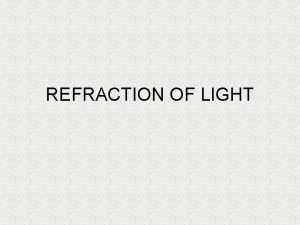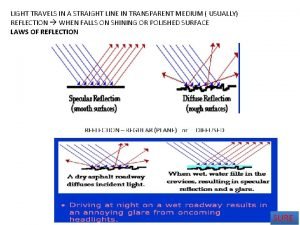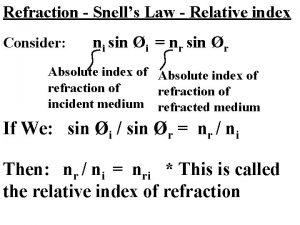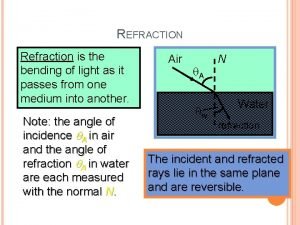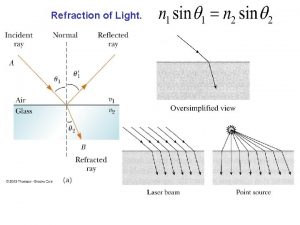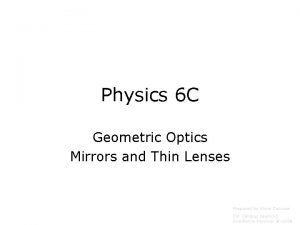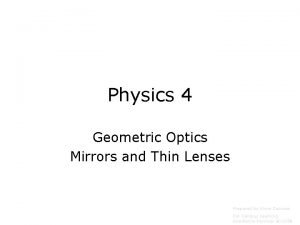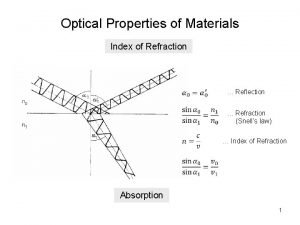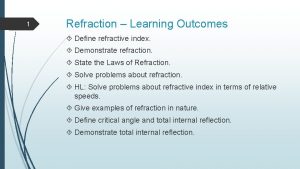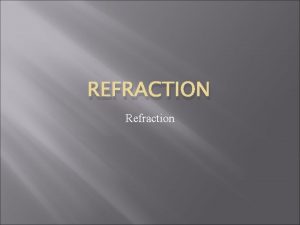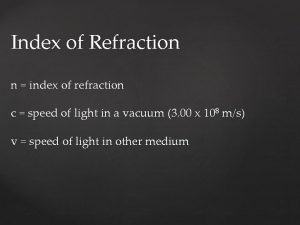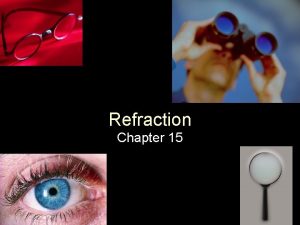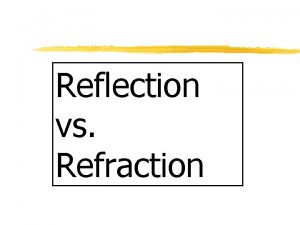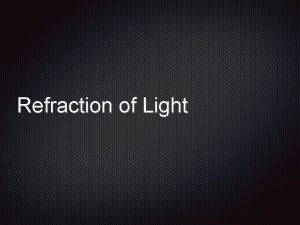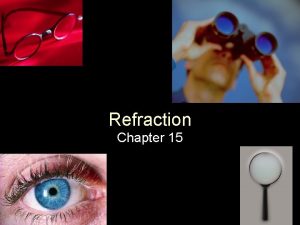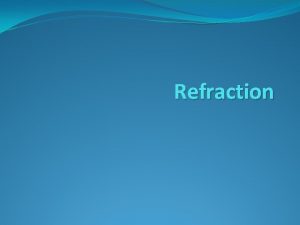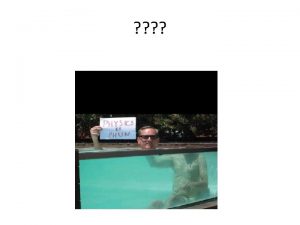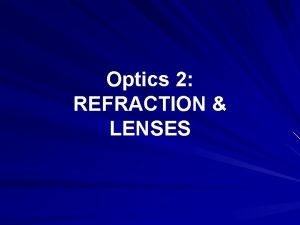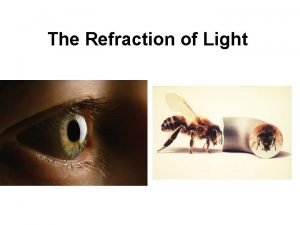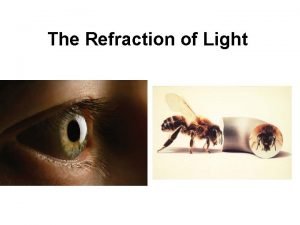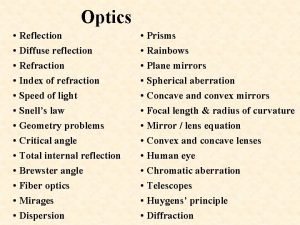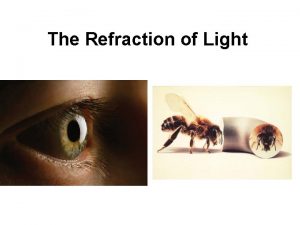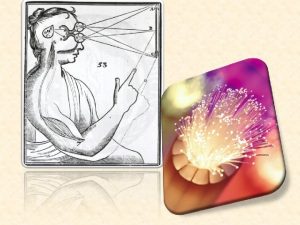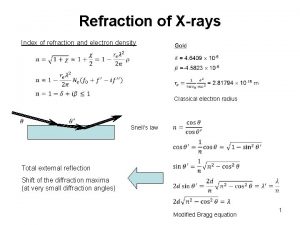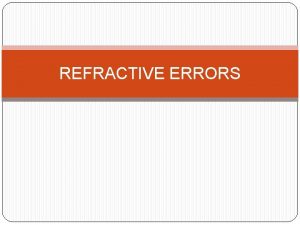1 Refraction Learning Outcomes Define refractive index Demonstrate

























- Slides: 25

1 Refraction – Learning Outcomes Define refractive index. Demonstrate refraction. State the Laws of Refraction. Solve problems about refraction. HL: Solve problems about refractive index in terms of relative speeds. Give examples of refraction in nature. Define critical angle and total internal reflection. Demonstrate total internal reflection.

2 Refraction – Learning Outcomes Solve problems about total internal reflection. Give uses and natural occurrences of refraction. Discuss transmission of light in optical fibres. Give uses of optical fibres.

3 Refraction is the bending of light as it passes from one medium to another.

4 To Demonstrate Refraction 1. Aim a narrowed beam from a ray box at the side of a block of glass. 2. Vary the angle of incidence and note that the angle of refraction increases with angle of incidence. 3. Note that the ray exiting the block is parallel to the incident ray.

5 Laws of Refraction

6 Refractive Index Material Vacuum Air Water Refractive Index 1 (by definition) 1. 0003 1. 33 Glass ~1. 5 (varies with glass) Diamond 2. 4 Germanium 4. 1

7 Snell’s Law e. g. A ray of light enters glass from air. The angle of incidence is 30 o and the angle of refraction is 19 o. What is the refractive index of the glass? e. g. A ray of light enters water from air. If the angle of incidence is 40 o, find the angle of refraction if the refractive index of water is 1. 33. e. g. Light enters water from glass. If the angle of incidence is 40 o and the angle of refraction is 46. 3 o, what is the refractive index between glass and water?

Depth 8

9 Depth e. g. Sorcha draws a mark on a sheet of paper and places a glass block with thickness 8 cm over it. When viewed from above the glass, the mark appears to be 5. 33 cm from the surface. What is the refractive index of the glass? e. g. A pool of water is 12 m deep. If the bottom of the pool is viewed from the air, how deep does it appear? nwater = 1. 33

10 Refraction in Nature – Bears have to recognise refraction when fishing – the fish appears to be higher up than it really is. Real fish by unknown artist – public domain Bear by Joseph Smit – public domain

11 HL: Speed of Light

12 HL: Speed of Light

13 Total Internal Reflection When light travels from a denser to a rarer medium, the critical angle, C is the angle of incidence which gives an angle of refraction of 90 o. Total internal reflection (TIR) occurs when light travelling from a denser to a rarer medium is incident at an angle greater than the critical angle.

14 To Demonstrate TIR 1. Aim a narrowed beam from a ray box at a semi-circular slab of glass 2. Aim the beam so that it is incident on the flat face of the slab internally. 3. Starting with a small angle of incidence, increase this angle. 4. When the critical angle is reached, the refracted ray skims along the flat face of the glass. 5. For higher angles of incidence, the refracted ray changes to a totally internally reflected ray.

15 To Demonstrate TIR

16 Total Internal Reflection

17 Total Internal Reflection e. g. The critical angle for a certain medium is 50 o. Find its refractive index. e. g. The refractive index of glass is 1. 5. What is the critical angle of glass?

18 TIR in Nature – Mirages The refractive index of air changes with temperature. On hot days, light from the sky can bend away from a road towards your eye, creating a “puddle” image.

By Brocken Inaglory from Wikipedia – CC-BY-SA-3. 0 19 TIR in Nature – Mirages

20 TIR in Nature – Snell’s Window Looking up while underwater, only light from within a certain radius will reach you – the rest is totally internally reflected from underwater. This is called Snell’s window.

by Jayme Pastoric – public domain 21 TIR in Nature – Snell’s Window

22 Uses Prism reflectors are used in road signs to ensure that light from headlights reflects back at the driver. Safety reflectors on bikes and cars use the same effect. Many modern devices use round reflectors, which work on the same principle.

23 Uses – Optical Fibres Optical fibres are thin transparent glass rods that can transmit light via total internal reflection.

by Timwether – CC-BY-SA-3. 0 24 Uses – Optical Fibres

25 Optical Fibres Optical fibres are used to transmit telephone, television, and internet signals as pulses of light. It is better than the old copper cables in pretty much every way – lower loss, lower size, lower interference. They are also used in medicine as flexible cameras, called endoscopes.
 Refractive index and velocity
Refractive index and velocity Permittivity refractive index relation
Permittivity refractive index relation Refractive index of polystyrene
Refractive index of polystyrene Conoid sturm
Conoid sturm What is cmc in physical pharmacy
What is cmc in physical pharmacy Negative refractive index
Negative refractive index Complex refractive index
Complex refractive index What causes glass to fracture into shards when broken?
What causes glass to fracture into shards when broken? Drude model refractive index
Drude model refractive index Perspex refractive index
Perspex refractive index Refractive index of substances
Refractive index of substances How to calculate angle of refraction
How to calculate angle of refraction Refractive index applications
Refractive index applications Refractive index of slimline 750
Refractive index of slimline 750 Relative index of refraction
Relative index of refraction Index of refraction of jello
Index of refraction of jello Index of refraction of jello
Index of refraction of jello Snell law
Snell law Index of refraction of jello
Index of refraction of jello Index of refraction of jello
Index of refraction of jello Concaver
Concaver Index of refraction sample problems
Index of refraction sample problems Index of refraction of corn syrup
Index of refraction of corn syrup Index of refraction formula with angles
Index of refraction formula with angles Clinical refraction definition
Clinical refraction definition Learning objectives of refraction of light
Learning objectives of refraction of light
